Old Dog, New Tricks
So I have this camera, a Canon Digital Rebel that's better, way better, than I am, smarter too. And until now I've put it on two settings, both automatic, one that permits flash and one that doesn't, and I've been utterly at the mercy of whatever light there happens to be out there. So occasionally, when I'm shooting at a white bird on a dark background, the white bird gets overexposed -- blown out-- and the detail disappears. Or if I'm shooting a moving bird in poor light, the moving parts get blurred. And though I've been delighted with what happens then (see the Sunset Beach post!) I've also known there are things I could be doing to counter that.
Enter Lillian Stokes, she who gently nudged me toward a digital SLR in the first place, toward higher megapixels and interchangeable lenses, and I haven't been sorry for a moment that I took the leap.
Don and Lillian were at my talk at Ding Darling NWR on January 18, and I shoved my camera into her capable hands, and she took a ton of pictures of what went on, happy to be given a camera to play with.
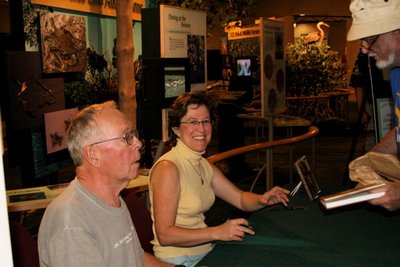 Photo by Lillian Stokes
Photo by Lillian StokesShe is very skilled; she made me look acceptable! She's a portraitist, among other things, and she knows when her subject looks good and when it doesn't.
The line took over an hour to clear, and I signed maybe 50 books.
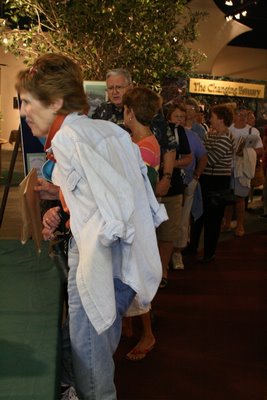 Photo by Lillian Stokes
Photo by Lillian StokesI love what happens when I get to meet people who are interested in my work. So many quick but heartfelt conversations.
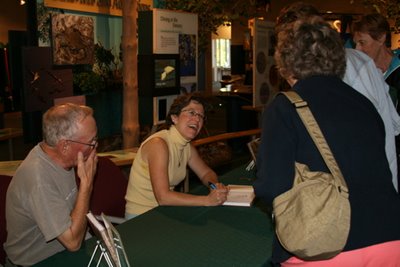 Photo by Lillian Stokes
Photo by Lillian StokesHere, I'm refusing to sign Don Stokes' book, saying I'll catch him later.
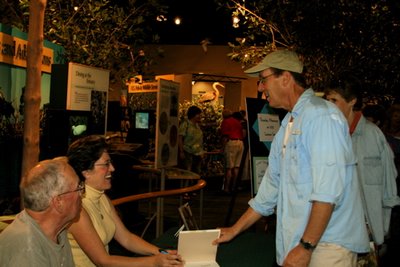 Photo by Lillian Stokes
Photo by Lillian StokesLillian is really something. I'm sure the fact that I didn't have the faintest idea how to use my nice new camera was driving her nuts. So she offered to meet me at 5, a couple of hours after the signing ended, to show me a few things. I went out on the refuge by myself to bang away at the birds, all the while wondering what new things Lillian would be able to teach me. I'm the proverbial old dog. And I have to confess that when I've looked at professional photographers' work, I have always ignored the f-stop and ISO and aperture stuff as just so much Greek.
An hour with Lillian changed all that. She is a dynamo, and she has a natural way of teaching that makes counter-intuitive things suddenly understandable. We raced the dying sunset to Captiva Island, where there was a bit of beach where we could practice. And there was a group of tourists who saw the opportunity to co-opt Lillian into taking their picture. She made them take off their sunglasses, and she wouldn't take no for an answer. It was so cute! You ask a pro to take your picture, and you hand over a certain amount of control. Even if she's using your tiny point-and-shoot. Lillian can't help it: she's compelled to make the best picture possible under the circumstances.
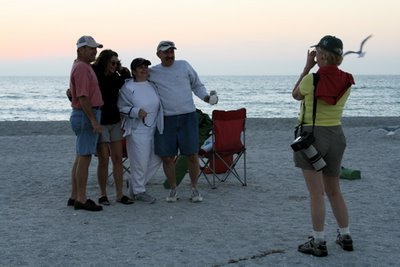
Lurking behind the tourists was a great blue heron who I feel sure came down from heaven to make sure I learned what Lillian was trying to teach me. It offered itself up and kept coming back and posing for us until the sun sank below the horizon and I finally got it.
The sun was sinking fast when we got there, and without having a chance to ask Lillian any questions, I crouched down on the sand and took some images of the bird against the sunset. Soon I was lying on my side, risking an earful of sand, completely lost in the beauty I was trying to capture.
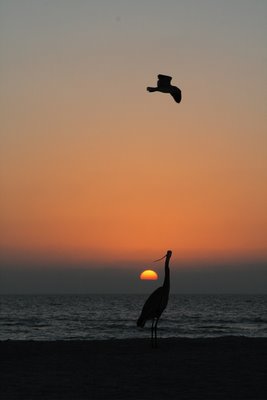
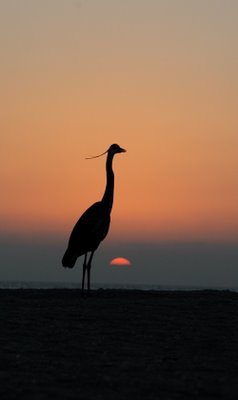
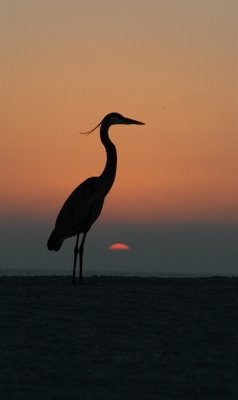 With the camera set to automatic, without flash, I had only a silhouetted heron. Granted, some very nice images, some I'm happy with. But there was more to learn.
With the camera set to automatic, without flash, I had only a silhouetted heron. Granted, some very nice images, some I'm happy with. But there was more to learn.Here's how little light there was when the sun was gone. Practically none. I could barely pick up any features or markings on the bird. Lillian grabbed my camera and said, "Now let me show you something." My last shot, the wind combing the heron's plumes to look like Garuda, a Balinesian god.
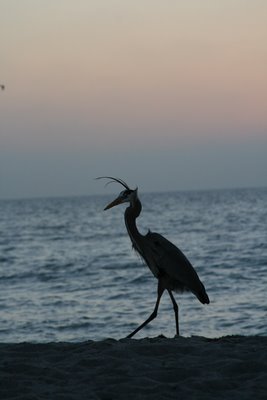
She set my camera to AV, which she told me all the nature photographers use because it allows you to program "film" speed (ISO) and aperture (the diameter of the opening that allows light into the lens, commonly known as f-stop).
She dialed the speed up to 400, and opened the aperture up a couple of stops. And magic happened. Instead of the painterly blurs I'd gotten at the first sunset I'd shot, suddenly detail appeared on the bird. Remember, there's almost no light by now, less than when I'd started. The water should have been a blur; the bird a silhouette.
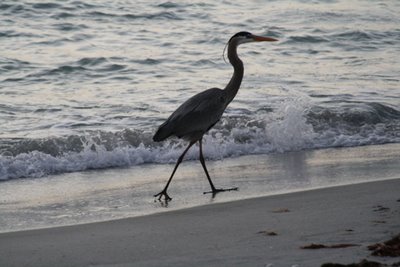 Photo by Lillian Stokes
Photo by Lillian StokesAnd yet here it is, with features and color, and its legs are sharp though moving quickly, and the wave is frozen in mid-fall. That's the fast "film" speed (ISO) and the wide-open aperture working. I was floored. The Rebel was sucking in light, just like my little point and shoot Olympus does. Oh!
There's still going to be room for the art shots. But now I have the understanding that gives me the choice to make a shot whatever I want to make it. I'm beginning to get it. Serendipity will always play the largest part. And thanks to Lillian's generosity and this one lesson, I now understand something about making a photograph, rather than simply taking it.
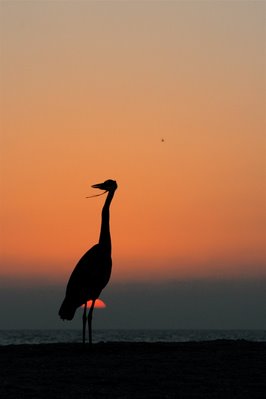 More on f-stops and light in later posts. A note: I wrote this post at probably the exact same time Lillian was writing hers on the Stokes Birding Blog.
More on f-stops and light in later posts. A note: I wrote this post at probably the exact same time Lillian was writing hers on the Stokes Birding Blog.To see the photos that Lillian took of the same scene, check it out! I find it fascinating to see how different our photos are--two photographers, one professional, one trying; same subject. It all makes me think about the art of photography, and the passion each individual is able to bring to it. Knowledge sure helps. Thanks, Lillian!






<< Home